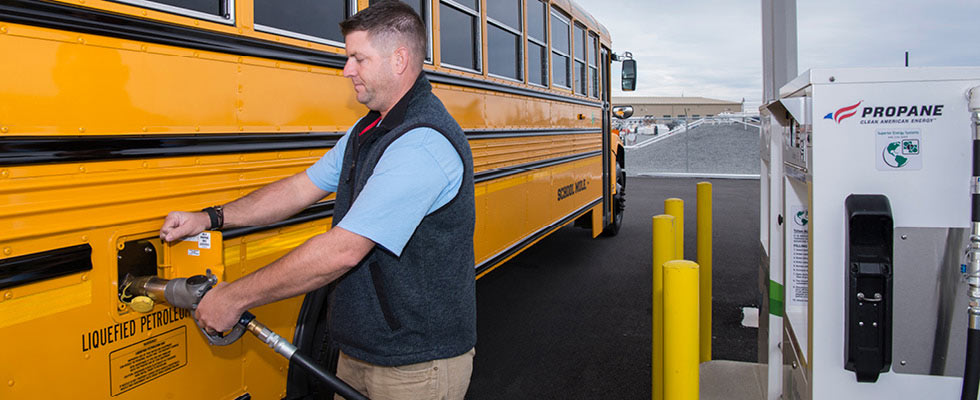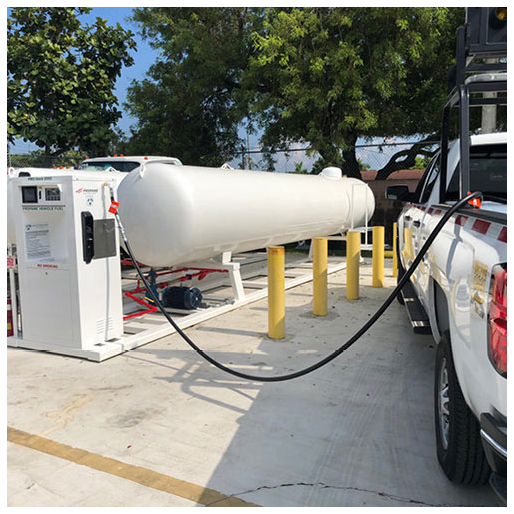
Autogas is a growing sector of the propane industry — one that’s important to stay informed about as the industry works harder and harder to get more fleets to implement the fuel. Ahead, Derek Rimko, vice president of operations for Superior Energy Systems, and Todd Mouw, executive vice president for ROUSH CleanTech, provide insights into refueling infrastructure, the best talking points in discussions with fleet management, and why this fuel stands out as the superior choice for propane marketers as well.
What makes autogas a superior alternative fuel choice for fleets?
Rimko: There are many benefits to autogas, but the most important one is that autogas has the lowest cost of ownership of any alternative fuel. You will meet fleets that want to/have to lower their emissions, and you will meet fleets that want the “green” aspect alternative fuels provide for their company reputation — but you will never meet a fleet that will turn down saving money.
Mouw: Each alternative fuel has its pros and cons, but autogas checks many of the required boxes for fleet operators, especially for Class 4-7 vehicles where electric vehicles really are not commercially viable today. Autogas offers comparable range to diesel. It provides a significant cost reduction due to the differential in fuel prices. The industry has made significant inroads in growing the supply of renewable propane, which offers fleets a path to a near-zero solution without compromising range or available payload. Infrastructure is much simpler and lower cost than any alternative option as well. Propane also thrives in the winter months, providing heat much faster to the occupants of trucks and school buses without range sacrifices.
Can you give an overview on the state of autogas refueling station infrastructure?
Rimko: School buses are obviously a substantial user in the U.S., but we have seen the market outside of school buses grow with larger fleets, like package delivery providers expanding their autogas fleets. Many of these fleets, including school buses, have tested other alternative fuel vehicles and come back to autogas thanks to its reliability, economic value, scalability and low emissions. The quality of both the vehicles and infrastructure play a large part in that, and fleets have also come to trust the equipment and manufacturers. We expect autogas to continue its upward trend thanks to these characteristics and to continue to compete against electric vehicles in the alternative energy space as fleets recognize what it takes to run those fleets versus autogas. Infrastructure still has room for growth in other fleet segments, such as transit. There is also a significant number of marketers who have not added autogas to their offerings, and there is plenty of room for growth amongst them as they approach new and existing fleets.
 Mouw: The industry has made significant strides to make the user experience more user friendly when it comes to infrastructure. The implementation of the Euro/quick-connect filling nozzle has been a great change for the operators and has further reduced fugitive emissions during the fill process. The standardization of equipment and specifications to ensure a truck and school bus get a comparable fill rate to diesel has been another gain. The emergence of renewable propane as a near-zero solution is a game changer — it’s a drop-in with no change to the infrastructure or vehicle technology. As an industry, I think we can always improve. How we communicate pricing to customers has to get more consistent. There should be an understanding of an autogas price and also the price for the traditional uses of propane. Listing available locations for fleets to fill, hours of operation, etc., on public-facing websites and apps needs to improve.
Mouw: The industry has made significant strides to make the user experience more user friendly when it comes to infrastructure. The implementation of the Euro/quick-connect filling nozzle has been a great change for the operators and has further reduced fugitive emissions during the fill process. The standardization of equipment and specifications to ensure a truck and school bus get a comparable fill rate to diesel has been another gain. The emergence of renewable propane as a near-zero solution is a game changer — it’s a drop-in with no change to the infrastructure or vehicle technology. As an industry, I think we can always improve. How we communicate pricing to customers has to get more consistent. There should be an understanding of an autogas price and also the price for the traditional uses of propane. Listing available locations for fleets to fill, hours of operation, etc., on public-facing websites and apps needs to improve.
Does autogas provide a better return on investment for fleet management in terms of time spent refueling, how often trucks typically need to be refueled, etc.?
Rimko: It is not so much about time as it is whether the fleet even has the ability of enough downtime for time-consuming refuels or recharge. Take a transit fleet, for example: They tend to offer transport to their customers for a large portion of the day, if not 24/7, which gives them little time to refuel. In this instance, autogas makes a lot of sense because refueling can take a couple of minutes as opposed to hours for charging electric vehicles. A typical fleet vehicle can refuel with a Superior Energy Systems’ autogas dispenser in less than five minutes at approximately 10 gallons per minute. This refueling time is a similar, if not a better, amount of time than the gasoline and diesel refueling durations.
Mouw: This is a soft cost that we talk to our fleets about. In most cases our product provides similar range to their gas or diesel counterpart, so the labor costs spent fueling vehicles is comparable. The savings that should get discussed more are related to how long school districts idle diesel buses to get them to warm up in the morning compared to how quickly propane buses warm up. There are hard costs on the diesel side, such as additional fuel burn and labor arriving earlier to start the buses — not to mention the additional emissions from diesel bus idling.
What are the best entry points for marketers to convince fleet management to switch to autogas?
Rimko: Scalability — Autogas refueling equipment can easily be expanded as the fleet’s needs change.
Low-carbon emissions — Autogas vehicles cut significantly more nitrogen oxide and greenhouse gas emissions compared with diesel and gasoline.
Economics — Historically, propane autogas is cheaper than gasoline or diesel and is more insulated from the price spikes of conventional fuels. There are also both federal and state tax benefits for fleets using autogas, and the cost of autogas infrastructure is significantly lower than other alternative fuels.
Ease of infrastructure — Autogas infrastructure options vary based on fleet size and most are simple to install in a minimal amount of time with a small footprint. In addition, refueling systems are easy to use and work similarly to conventional fuel refueling.
Fuel and equipment reliability — Autogas is plentiful in supply and available anywhere in the country. In addition, the equipment is technologically advanced, certified and reliable. The vehicles also do not require complex emission systems, which cause spikes in downtime for repairs, like some diesel vehicles.
Mouw: It starts with cost savings and getting to a business manager or chief financial officer. We are seeing a multitude of fleets save in excess of 34 cents per mile, so when you talk about a fleet with 10 to 20 or more assets in their fleet, they can do the math and understand the significant impact it can make on their organization. We also have to ensure we are talking about this change with all of the other influencers in the process — from drivers to technicians to first responders. There obviously is a huge push to reduce carbon footprint and harmful emissions, but if the financial picture does not box, it is tough to get a fleet to scale with a new technology.
Why should more marketers implement fleets that run on autogas? What steps can be taken to make this viable for marketers?
Rimko: In terms of marketers making the decision to sell autogas, let’s provide a quick example of gallons used. Superior Energy Systems recently installed a 30,000-gallon storage tank and four dispensers for a school district in Northwest Ohio. In the first two weeks following start up of that station, the district pumped over 10,000 gallons of autogas with minimal involvement from the marketer. The ROI is clear and there are hundreds of gallon-usage examples just like this across the country. In addition, most of these fleets are signing multiple-year contracts to lock in their supplier and price. To us, this makes a lot of sense. Marketers should start by talking to partners in autogas. The Propane Education & Research Council is an obvious choice for education and training, but we always encourage marketers to reach out to infrastructure and vehicle suppliers. The more information they have, the better equipped they are to approach fleets, and the majority of those manufacturers are going to be more than happy to help. We often come alongside a marketer as they meet with a fleet to discuss what their needs are and as they begin some of the more technical aspects of permitting and engineering. Don’t be afraid to reach out.
Mouw: Look at the financial impact on your organization. Think about saving 34 cents-plus per mile in your own fleet. Think about operating the fuel that you sell and promote in your community. Think about a school district you want to sell propane to asking you, “Why don’t you run propane in your own fleet?” The technology works. The savings are significant. It is easier to find technicians to work on a spark-ignited engine than a diesel engine. It reduces harmful emissions in the communities that you work and live in. With diesel likely getting regulated out of the Class 4-7 segment, now is our time to take advantage of the opportunity.


